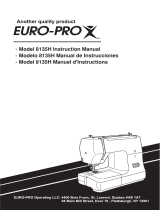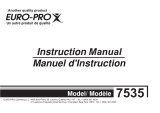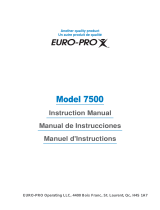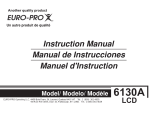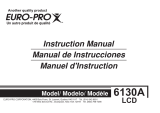Page is loading ...

Estimado Cliente
E
GB
F
A titre de nouveau propriétaire d'une machine à coudre , vous pourrez
apprécier une couture de qualité sur tous les genres de tissus, que ce soit plusieurs
épaisseurs de denim ou de la soie délicate.
Votre machine à coudre offre ce qu'ilyademieux en fait de simplicité et de
facilité d'usage. Pour votre sécurité et afin de pleinement apprécier les nombreux
avantages de votre machine à coudre, nous recommandons que vous lisiez toutes les
mesures de sécurité et les instructions qui sont contenues dans le présent manuel.
Permettez-nous de vous suggérer, avant d'utiliser votre machine à coudre, de découvrir
les nombreuses caractéristiques et avantages en feuilletant ce manuel, étape par étape,
assise face à votre machine à coudre.
EURO-PRO
EURO-PRO
As the owner of a new sewing machine, you will enjoy precision quality
stitching on all types of fabrics, from multiple layers of denim to delicate silks.
Your sewing machine offers the ultimate in simplicity and ease of operation.
For your safety and to fully enjoy the many advantages and ease of operation of your
sewing machine, we recommend that you read all the important safeguards and use and
care instructions in this instruction book.
May we suggest that before you start to use your sewing machine, you discover the
many features and advantages by going through this instruction book, step by step, while
seated at your sewing machine.
EURO-PRO
EURO-PRO
Le felicitamos muy cordialmente por su nueva máquina de coser.
Vd. acaba de comprar un producto de calidad que ha sido fabricado con el máximo
cuidado. Su máquina de coser es fácil de usar pero naturalmente hay que seguir las
reglas. Y estas las hemos especificado en este manual de instrucciones. Si Vd. les
presta atención entonces realizará sus trabajos perfectamente desde el comienzo.
Por supuesto que usted tendrá algunas preguntas que en este manual no hemos podido
responder en forma total. En tal caso acuda a nuestro representante o distribuidor
autorizado quien estará siempre a su disposición.
Le deseamos un buen trabajo con su máquina y que pueda dar rienda suelta a su
fantasía.
Félicitations
Congratulations

List of contents
GB
Principal parts .................................................................................................................2/4
Accessories........................................................................................................................6
Fitting the snap-in sewing table..........................................................................................8
Connecting machine to power source..............................................................................10
Changing the bulb............................................................................................................12
Two-step presser foot lever/ Adjusting the presser foot pressure....................................14
Attaching the presser foot holder .....................................................................................16
Winding the bobbin ..........................................................................................................18
Inserting bobbin................................................................................................................20
Changing the needle (system 130/ 705H)........................................................................22
Threading the upper thread..............................................................................................24
Automatic needle threader...............................................................................................26
Thread tension .................................................................................................................28
Bringing up the lower thread ............................................................................................30
Reverse sewing/ Changing sewing directions/
Removing the work/ Cutting the thread.......................................................................32
How to drop feed dog.......................................................................................................34
Matching needle / fabric / thread......................................................................................35
How to choose your pattern .............................................................................................38
Straight stitching and needle position ..............................................................................40
Zig zag sewing .................................................................................................................42
Blind hem/ lingerie stitch ..................................................................................................44
Overlock stitches..............................................................................................................46
Sewing on buttons............................................................................................................48
How to sew buttonholes (one-step buttonhole)................................................................50
Left and right side balance for buttonhole........................................................................52
Zippers and piping............................................................................................................54
Sewing with the hemmer foot...........................................................................................56
3-step zig-zag...................................................................................................................58
Stitch selection.................................................................................................................60
Smocking stitch................................................................................................................62
Sewing with the cording foot ............................................................................................64
Free motion darning.........................................................................................................66
Practical stitches ..............................................................................................................68
Darning.............................................................................................................................70
Attaching lace...................................................................................................................72
Applique ...........................................................................................................................74
Twin needle......................................................................................................................76
Monogramming and embroidering with embroidery hoop* ..............................................78
Quilting.............................................................................................................................80
Gathering .........................................................................................................................82
Scallop stitching ...............................................................................................................84
Patch work .......................................................................................................................86
The walking foot accessory (optional)..............................................................................88
Maintenance.....................................................................................................................90
Trouble shooting guide.....................................................................................................92

GB
2
Principal parts
1. Thread tension dial
2. Presser foot pressure
3. Thread take-up lever
4. Thread cutting
5. Presser foot
6. Needle plate
7. Sewing table and accessory box
8. Bobbin stopper
9. Stitch length dial
10. Stitch width dial
11. Stitch display
12. Reverse sewing lever
13. Drop feed control
14. One step buttonhole lever
15. Automatic threader
3
1
2
4
5
6
7
8
11
12
9
10
13
14
15

GB
4
Principal parts
26.
16. Handle
17. Bobbin winder
18. Spool pin
19. Handwheel
20. Pattern selector dial
21. Power switch
22. Main plug socket
23. Bobbin thread guide
24. Upper thread guide
25. Presser foot lever
Buttonhole stitch balance adjustment slot
18
16
19
20
21
22
17
25
24
23
26

Bonus Feet (2)Standard Accessories (1)
13. Overlock foot
14. Satin stitch foot
15. Darning/Embroidery foot
16. Cording foot
17. Quilting foot
18. Gathering foot
19. Roll hemming foot
20. Walking foot
Optional Accessories (3)
This accessory is not
supplied with this sewing
machine; it is however
available as a special
accessory by calling our
customer service at
1 (800) 361-4639.
21. Twin needle
13
3
1. All purpose foot
2. Zipper foot
3. Button sewing foot
4. Buttonhole foot
5. Blind hem foot
6. L-screwdriver
7. Seam ripper / brush
8. Oil bottle
9. Pack of needles (3x)
10. Bobbin (3x)
11. Seam guide
12. Spool pin felt (2x)
1
2
3
4
5
6
7
8
9
10
11
12
14
15
16
17
18
19
20
21

GB
Fitting the snap-in sewing table
Hold the snap-in sewing table horizontal, and push it
in the direction of the arrow. (1)
The inside of the snap-in sewing table can be utilized
as an accessory box.
To open, lift up at the point of the arrow. (2)
8
1
2

GB
Connecting machine to power source
10
a
b
3
4
1
2
A
B
Caution:
Attention:
Always make sure that the machine is unplugged from power source
and the main switch is on "O". when the machine is not in use and
before inserting or removing parts.
Consult a qualified electrician if in doubt as to connect machine to
power source. Unplug power cord when machine is not in use.
The appliance must be used with the foot controller 4C-316B (110-
120V area)/ 4C-126G or 4C-326G (230V area)/ 4C-316C or 4C-326C
(220-240V area) manufactured by MATSUSHITA ELECTRIC
(TAIWAN) CO., LTD.
- This machine is equipped with a polarized plug which must be used
with an appropriate electrical outlet.
- Connect the machine to a power source as illustrated (1/2).
- The power switch is located above the terminal box. Your machine
will not operate unless this switch is on " I ". (1)
- Sewing light turns on automatically when the main switch is on " I ".
- To start the machine, press on the foot control (4). The speed of
the machine is regulated by the amount of pressure exerted on the
foot control.
a. Polarized attachment plug
b. Conductor intended to be grounded
IMPORTANT NOTICE
For appliance with a polarized plug (one blade is wider than the other).
To reduce the risk of electric shock, this plug is intended to fit in a
polarized outlet only one way. If it does not fit fully in the outlet,
reverse the plug. If it still does not fit, contact a qualified electrician to
install the proper outlet. Do not modify the plug in any way. (3)

GB
Changing the bulb
Caution:
Make sure to disconnect the electrical supply plug
from wall outlet before changing light bulb.
- Loosen screw (A) as illustrated. (1)
- Remove the cover (B).
- Unscrew the bulb and fit new one (C). (2)
- Replace the cover and tighten screw.
Replace bulb with same type rated 10 watts (110-
120V area).
12
1
A
B
2
C

GB
A
Adjusting the presser foot pressure
Two-step presser foot lever
When sewing several layers or thick fabrics, the
presser foot can be raised a second stage for easy
positioning of the work. (A)
The presser foot pressure of the machine has been
pre-set and requires no particular readjustment
according to the type of fabric (light-or-heavy weight).
However, if you need to adjust the presser foot
pressure, turn the presser adjusting screw with a coin.
For sewing very thin fabric, loosen the pressure by
turning the screw counter clockwise, and for heavy
fabric, tighten by turning it clockwise.
14

GB
Attaching the presser foot holder
Attention:
Turn power switch to "O" before carrying out any of the
operations below.
Raise the needle to its highest position and raise the
presser foot lever. Attach the presser foot holder (b) to
the presser foot bar (a). (1)
Lower the presser foot holder (b) until the cut-out (c) is
directly above the pin (d). (2)
Lower the presser foot holder (b) and the presser foot (f)
will engage automatically.
Raise the presser foot.
Release the pressure foot by raising lever (e) located at
the back of the foot holder. (3)
Attach the seam guide (g) in the slot as illustrated. Adjust
the distance as required for hems, pleats, etc.... (4)
Attaching the presser foot:
Removing the presser foot:
Attaching the seam guide:
16
4
1
2
3
e
b
a
a
c
d
e
f
b
g

GB
Winding the bobbin
a
18
1
Please Note:
When the bobbin winder spindle is in
"bobbin winding" position, the machine
will not sew and the hand wheel will
not turn. To start sewing, push the
bobbin winder spindle to the left
(sewing position).
a. Spool pin felt
Press the foot control gently. The bobbin will stop winding when it is full. Push the bobbin to
the left to "sewing position" and remove it.
Place an empty bobbin on the
bobbin winder spindle.
Take the thread from the spool
through the bobbin winder
tension disc. (1)
Wind the thread a few times by
hand around the empty bobbin in
a clockwise direction. Push the
bobbin to the right towards the
bobbin winding position. (2)
2

GB
Inserting bobbin
Attention:
Turn power switch to "O" before inserting or removing the
bobbin.
When inserting or removing the bobbin, the needle must be
fully raised.
- Open the hinged cover. (1)
- Hold the bobbin case with one hand. Insert the bobbin so
that the thread runs in a clockwise direction (arrow). (2)
- Pull the thread through the slot, down and to the left until it
enters the delivery eyelet (rectangular opening) under the
tension spring. (3)
- Hold the bobbin case by the hinged latch. (4)
- Insert the bobbin case fully into the shuttle race and release
the latch. Make sure that the metal finger fits into the notch
at the top of the race cover. (5)
20
3
4
1
2
5

Caution:
Turn power switch to "O" before
inserting or removing the needle.
Replace the needle at the first sign of
thread breakage or skipped stitches.
Select the correct type and size of
needle for the fabric to be sewn. Turn
the balance wheel towards you until
the needle is at highest position.
Loosen the needle clamp screw (A)
and tighten again after inserting the
new needle. (1)
The flat side of the needle shaft
should be facing away from you (B).
Push the needle up (C) into the
needle clamp as far as it will go (D).
Tighten the needle clamp screw firmly.
The sewing needle must always be
straight and sharp for smooth sewing.
Replace the needle (2) if it is bent (A),
blunt (B) or the point is damaged (C).
GB
Changing the needle (System 130/705H)
A
B
C
D
22
1
2
AB
C

2 3
5
1
6
4
a
Caution:
Before threading, turn power switch
to “0”.
Raise the needle bar to its highest
position. Follow exactly the numbered
threading sequence illustrated.
If you skip a step or fail to properly
engage the thread in any of the thread
guieds, the machine will not sew
properly. (Illustrations 1-5)
Continue to draw the thread down
and into the needle bar thread guide.
Insert the thread through the eye of
the needle from the front to the back.
Leave about 10 cm (4”) of thread loose
behind the needle. (Illustration 6)
a. Spool pin felt

- Raise the needle to its highest
position.
- Press lever (A) right down.
- The threader automatically
swings to the threading position
(B).
- Take the thread around the
hook (C).
- Take the thread in front of the
needle round the hook (D)
from bottom to top.
- Release lever (A).
- Pull the thread through the
needle eye.
Attention:
Turn power switch to off ("O")!
26
2
1
A
B
D
C
A
C
A
C
B
D
Automatic needle threader
GB

GB
Thread tension
28
1
B
C
A
Note:
The bobbin thread tension has
been adjusted at the factory and
readjustment is usually not
required.
Lower thread tension
To test the bobbin thread
tension, remove the bobbin case
and bobbin from the machine
and hold the bobbin case
suspended by the thread. Shake
it once or twice. If the tension is
correct, the thread will unwind
by about an inch or two. If the
tension is too tight, it will not
unwind. If the tension is too
loose, the thread will unwind for
more than two inches.
To adjust, turn the small screw
on the side of the bobbin case.
(1)
Upper thread tension
Basic thread tension setting: "4". (2)
To increase the tension, turn the dial up to a higher number. To reduce the tension, turn
the dial to a lower number.
A. Normal thread tension.
B. Thread tension too loose.
C. Thread tension too tight.
2

30
Bringing up the lower thread
GB
Hold the upper thread with the left
hand. Turn the handwheel towards
you with your right hand until the
needle goes down and comes up
again to its highest position. (1)
- Lightly draw the needle thread
forming a loop with the bobbin
thread. The upper thread should
have caught the lower thread in a
loop.
- Pull the needle thread toward you
and the lower thread will come up
from the bobbin in a large loop. (2)
Pull about 15 cm. (6") of both thread
away from you under the presser
foot.
2
1

32
Reverse sewing
GB
Reverse sewing is used for locking the end of seams and
where reinforcement is needed. At the end of seam, press
down the reverse sewing lever and touch the foot control
lightly. Sew a few reverse stitches. Release the lever and
the machine will sew forwards again (A).
A
1. Stop the machine at the point where you wish to change
directions with the needle still in the fabric.
2. Raise the presser foot and turn the fabric to line up its
new direction using the needle as a turning point.
3. Lower the presser foot and start sewing in the new
direction.
Turn the handwheel towards you to bring the thread take
up lever to its highest position. Raise the presser foot and
draw the fabric away from you.
Cutting the thread
Hold the threads behind the presser foot. Using both hands,
guide them to the slit (B) at the rear of the presser bar and
press down to cut the thread. You can also use the thread
cutter on the side of the machine.
Removing the work
Changing sewing directions
B

Matching needle / fabric / thread
GB
NEEDLE, FABRIC, THREAD SELECTION GUIDE
NEEDLE SIZE FABRICS THREAD
9-11(65-75)
12(80)
Lightweight fabrics-thin cottons, voile,
serge, silk , muslin, Qiana, interlocks,
cotton knits, tricots, jerseys, crepes,
woven polyester, shirt & blouse fabrics.
Medium weight fabrics-cotton, satin,
kettleclote, sailcloth, double knits,
lightweight woollens.
Medium weight fabrics-cotton duck,
woolen, heavier knits, terrycloth,
denims.
Heavyweight fabrics-canvas, woolens,
outdoor tent and quilted fabrics,
denims, upholstery material (light to
medium).
Heavy woollens, overcoat fabrics,
upholstery fabrics, some leathers and
vinyls.
IMPORTANT: Match needle size to thread size and weight of fabric
NEEDLE, FABRIC SELECTION
14(90)
16(100)
18(110)
Light-duty thread in cotton,
nylon or polyester.
Most threads sold are medium
size and suitable for these
fabrics and needle sizes. Use
polyester threads on synthetic
materials and cotton on natural
woven fabrics for best results.
Always use the same thread on
top and bottom.
Heavy duty thread, carpet
thread. (Use heavy foot
pressure-large numbers.)
Standard sharp needles. Sizes
range thin to large. 9 (65) to 18
(110)
Semi-ball point needle, scarfed.
9 (65) to 18 (110)
Full ball point needle 9 (65) to
18 (110)
Leather needles. 12 (80) to 18
(110)
Note:
1. Twin needles, can be purchased for utility and decorative work.
2. When sewing with twin needles, the stitch width dial should be set at less than "2.5".
3. European needles show sizes 65, 70, 80 etc. American and Japanese needles show size 9, 11,
12 etc.
4. Replace needle often (approximately every other garment ) and / or at first thread breakage or
skipped stitches.
Natural woven fabrics-wool, cotton, silk,
etc. Qiana. Not recommended for
double knits.
Natural and synthetic woven fabrics,
polyester blends. Knits-polyesters,
interlocks, tricot, single and double
knits. Can be used instead of 15 1 for
sewing all fabrics.
NEEDLES EXPLANATION TYPE OF FABRIC
Sweater knits, Lycra, swimsuit fabric,
elastic.
Leather, vinyl, upholstery. (Leaves
smaller hole than standard large
needle.)
HA 1
15 1
15 1/705H
(SIN)
15 1/705HS
(SUK)
130 PCL
35

How to choose your pattern
GB
38
Q
O
P
M
L
N
G
H
I
J
K
C
D
E
F
B
A
For select pattern
"A" with pattern selector dial (4).
Adjust the stitch length with the
stitch length dial (2). You may
choose any needle position, by
turning the stitch width dial (1).
For , select pattern
"B" with pattern selector dial (4).
Adjust the stitch length (2) and
stitch width (1) according to the
fabric being used.
To obtain any of the other
on the stitch selection panel,
select the letter above the stitch
with the pattern selector dial.
Adjust the stitch length and the
stitch width with the control dials
according to the result desired.
To obtain any of the
, turn the stitch
length dial to "S", select the
pattern desired with pattern
selector dial, and adjust the
stitch width with the stitch width
dial.
straight stitch
zigzag stitch
patterns shown in the upper row
patterns on
the second row
1. Stitch width dial
2. Stitch length dial
3. Stitch display
4. Pattern selector dial
5. Reverse sewing lever
5
4
3
21
/
